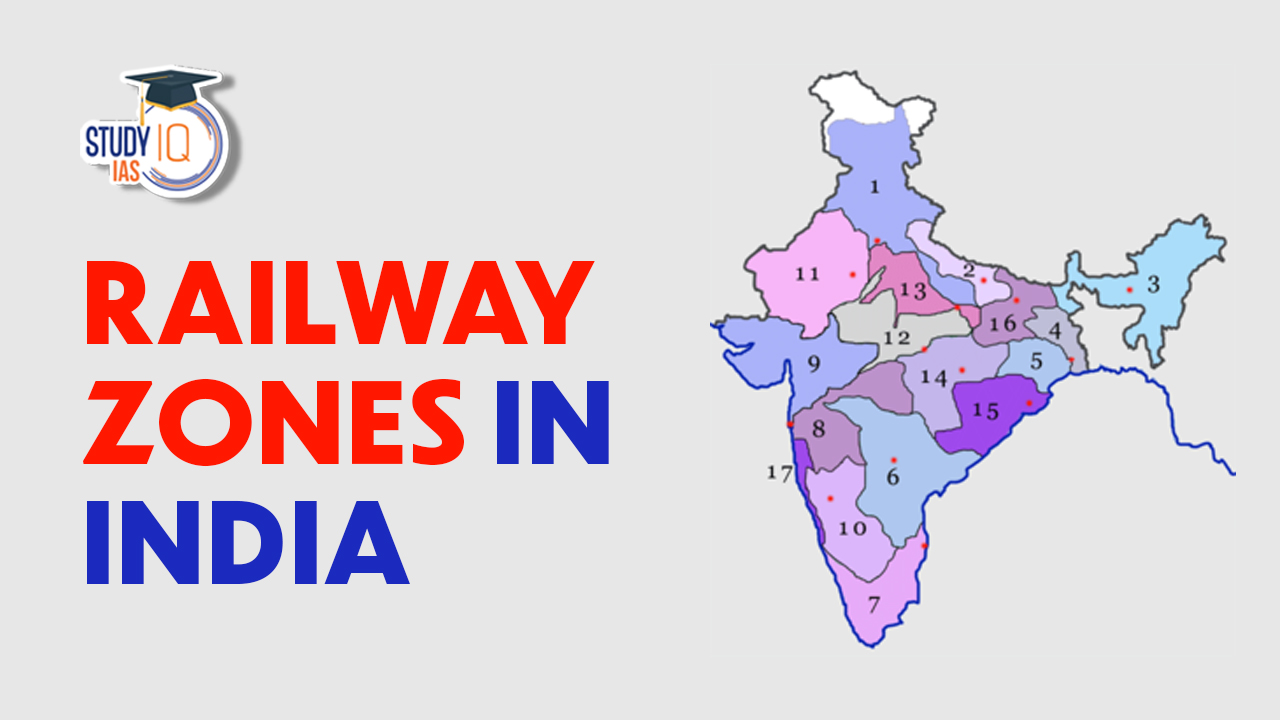Table of Contents
The Indian Railways, a cornerstone of India’s transportation infrastructure, is one of the world’s largest railway networks. India has a total of 19 railway zones as of 2024. The latest addition is the South Coast Railway Zone (SCoR), which is based in Visakhapatnam and was announced in 2019. These zones are subdivided into divisions to facilitate effective management and operations of the Indian Railways network.
Its operations are divided among various zones to ensure efficient management and service delivery across the country. This article provides an in-depth look at the railway zones in India, their headquarters, divisions, and other critical details that are essential for UPSC preparation and understanding the functioning of this vast system.
Creation of South Coast Railway (SCoR) Zone
- The Union Cabinet approved the creation of the South Coast Railway (SCoR) Zone with ex post facto approval.
- SCoR becomes the 18th railway zone of Indian Railways. It is carved out from the East Coast Railway (ECoR) and South Central Railway (SCR).
- The new railway zone was created under the Andhra Pradesh Reorganisation Act, 2014, which led to the formation of Telangana.
Divisions Under South Coast Railway (SCoR) Zone
- The new railway zone will cover a major part of Andhra Pradesh, along with portions of Telangana and Tamil Nadu.
- The following divisions will be included:
- Vijayawada Division (from South Central Railway).
- Guntur Division (from South Central Railway).
- Part of Waltair Division → renamed Visakhapatnam Division under SCoR.
- The remaining part of the Waltair Division will form a new division headquartered at Rayagada, Odisha, under the East Coast Railway.
- Waltair Division is a major revenue-generating division due to its freight traffic linked to the mining and steel industries of Odisha and Chhattisgarh.
About Railway Zones in India
Indian Railways, one of the world’s largest railway networks, operates over 67,000 kilometres of track and serves more than 23 million passengers daily. To efficiently manage this extensive network, the Indian Railways is divided into 19 zones, each responsible for specific regions. This article provides a detailed overview of these railway zones, their divisions, the states covered, and their importance to India’s transportation system.
List of Railway Zones in India and Their Headquarters
Indian Railways is structured into 19 zones and 70 divisions, with each zone overseen by a General Manager (GM) and each division headed by a Divisional Railway Manager (DRM). This hierarchical structure ensures efficient management and operation of the vast railway network. Each zone operates independently of its headquarters.
| Railway Zone | Divisions | Zonal Headquarters |
| Central Railway |
|
Mumbai |
| Eastern Railway |
|
Kolkata |
| East Central Railway |
|
Hajipur |
| East Coast Railway |
|
Bhubaneshwar |
| Northern Railway |
|
Baroda House, New Delhi |
| North Central Railway |
|
Allahabad |
| North Eastern Railway |
|
Gorakhpur |
| North Frontier Railway |
|
Maligaon, Guwahati |
| North Western Railway |
|
Jaipur |
| Southern Railway |
|
Chennai |
| South Central Railway |
|
Secunderabad |
| South Eastern Railway |
|
Garden Reach, Kolkata |
| South East Central Railway |
|
Bilaspur |
| South Western Railway |
|
Hubli |
| Western Railway |
|
Mumbai CST |
| West Central Railway |
|
Jabalpur |
How many Railway Zones are in India?
Indian Railways, one of the world’s largest rail networks, spans 123,236 kilometres across its 19 railway zones and 68 divisions as of 2022. Established on April 14, 1951, the southern zone was the first to be operational. These zones, managed by the Ministry of Railways, are crucial for overseeing the extensive network that connects millions of people and facilitates the transport of goods across India daily. With over 7,000 stations, Indian Railways efficiently manages trains, stations, tracks, and other operations essential for seamless transportation nationwide.
States Covered under Railway Zones in India
Railway zones cover different geographical regions of India and play crucial roles in managing and operating the extensive railway network across the country. Each zone is further divided into divisions, each headed by a Divisional Railway Manager (DRM), responsible for the day-to-day operations within their respective divisions.
| Railway Zone | Headquarters | States Covered |
|---|---|---|
| Northern Railway (NR) | Delhi | Delhi, Haryana, Uttar Pradesh, Punjab, Rajasthan, Jammu and Kashmir |
| North Central Railway (NCR) | Prayagraj (Allahabad) | Uttar Pradesh, Madhya Pradesh, Rajasthan |
| North Eastern Railway (NER) | Gorakhpur | Uttar Pradesh, Bihar, parts of West Bengal |
| Northeast Frontier Railway (NFR) | Maligaon, Guwahati | Assam, Arunachal Pradesh, Nagaland, parts of West Bengal, Bihar, Meghalaya |
| North Western Railway (NWR) | Jaipur | Rajasthan, Punjab, Haryana, parts of Uttar Pradesh |
| Eastern Railway (ER) | Kolkata | West Bengal, Jharkhand, Bihar |
| East Central Railway (ECR) | Hajipur | Bihar, Jharkhand, parts of Uttar Pradesh |
| East Coast Railway (ECoR) | Bhubaneswar | Odisha, Andhra Pradesh, Chhattisgarh |
| Southern Railway (SR) | Chennai Central | Tamil Nadu, Kerala, Puducherry, parts of Andhra Pradesh and Karnataka |
| South Central Railway (SCR) | Secunderabad Junction | Telangana, Andhra Pradesh, parts of Maharashtra and Karnataka |
| South Coast Railway (SCoR) | Visakhapatnam | Coastal Andhra Pradesh (Visakhapatnam and Vijayawada divisions) |
| South Eastern Railway (SER) | Garden Reach, Kolkata | West Bengal, Jharkhand, Odisha |
| South East Central Railway (SECR) | Bilaspur | Chhattisgarh, Odisha, parts of Maharashtra and Madhya Pradesh |
| South Western Railway (SWR) | Hubballi | Karnataka, parts of Tamil Nadu, Andhra Pradesh, Maharashtra |
| Western Railway (WR) | Mumbai | Maharashtra, Gujarat, parts of Rajasthan |
| West Central Railway (WCR) | Jabalpur | Madhya Pradesh, parts of Uttar Pradesh and Rajasthan |
| Central Railway (CR) | Mumbai | Maharashtra, Madhya Pradesh, parts of Karnataka and Andhra Pradesh |
| Konkan Railway (KR) | Navi Mumbai | Konkan region of Maharashtra, Goa, Karnataka |
| Metro Railway, Kolkata | Kolkata | Rapid transit system serving Kolkata, West Bengal |
History and Modern Significance of Indian Railways
Indian Railways has a rich historical legacy dating back to the colonial era when the first passenger train ran from Mumbai to Thane in 1853. Since then, it has grown exponentially to become a lifeline for India, connecting remote villages to major cities and supporting economic growth across diverse sectors.
In the modern era, Indian Railways continues to innovate with initiatives like electrification of rail routes, introduction of high-speed trains, and adoption of modern technologies for enhanced safety and efficiency.
Conclusion
The railway zones of India are integral to the nation’s economic development, social integration, and connectivity. They exemplify the scale and complexity of India’s railway network, reflecting its status as one of the world’s largest and most extensive transportation systems. As India progresses, its railway zones remain at the forefront of ensuring efficient and sustainable transport solutions for its vast population.
| Related Articles | |
| Indian Railways Safety Challenges | Railway Ecosystem in India |
| Kavach Train Protection System | Train Accidents in India |


 World Hemophilia Day 2025: Theme, Histor...
World Hemophilia Day 2025: Theme, Histor...
 International Days List of 2025, Importa...
International Days List of 2025, Importa...
 Major Dhyan Chand Khel Ratna Award Winne...
Major Dhyan Chand Khel Ratna Award Winne...





















